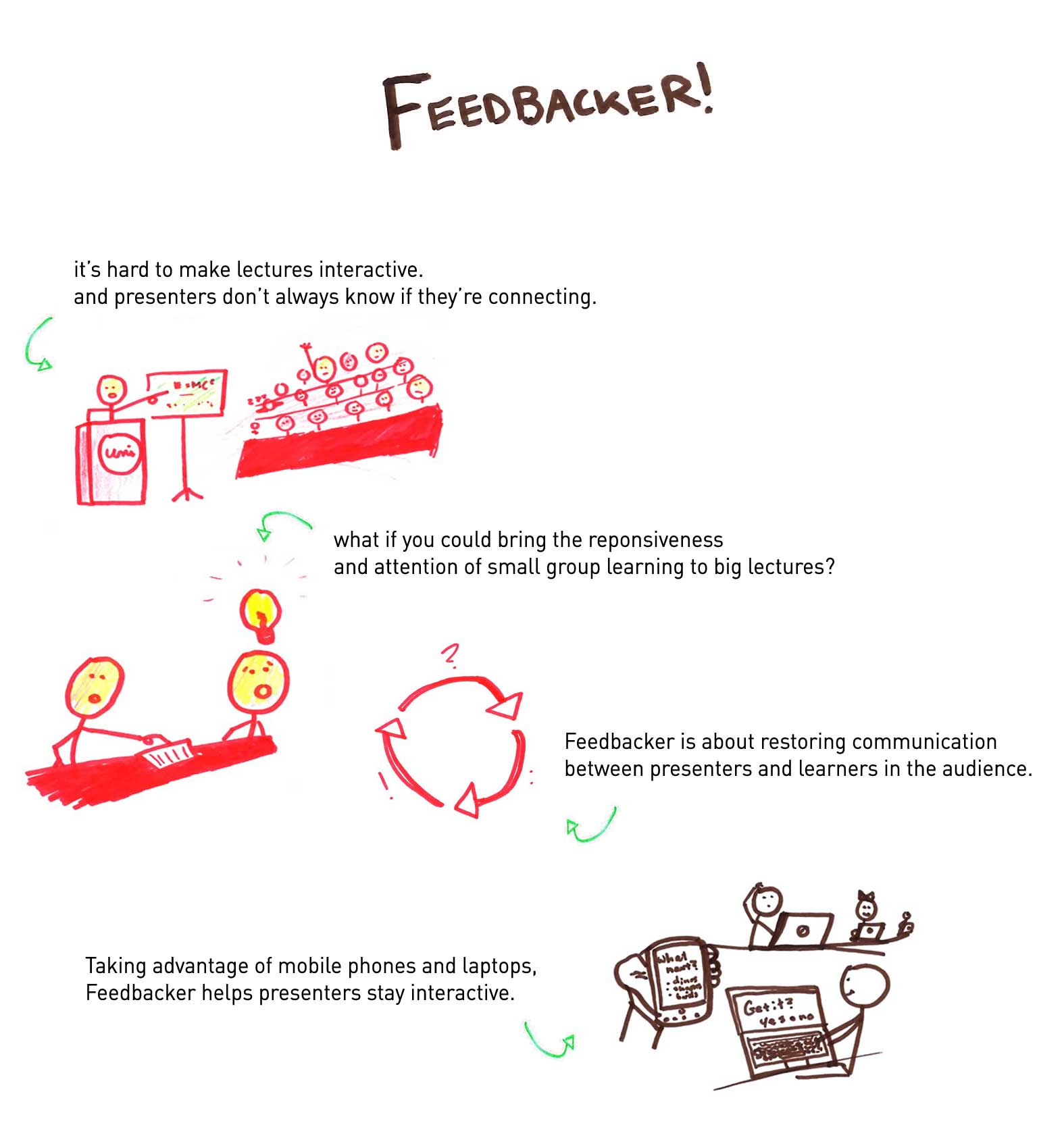Feedbacker: Flipping the Backchannel
I’m working with Sam Iglesias, Andrew First, Jade Davis, and the brilliant folks of FutureClass on an awesome project called Feedbacker. Here’s a video intro, and check out Cathy’s and Sam’s posts and the project wiki page. Read on for why I’m so excited about this one!
The new normal
If you spend a lot of time in classrooms, or conferences, or other audience settings, you’re no doubt aware of the “backchannel.”
If the speaker’s presentation is the primary conversation that’s taking place in the room, the backchannel is the secondary conversation. It’s the audience reacting together, sharing their questions, concerns, quibbles, reactions, and feedback. Sometimes, that secondary conversation can be more interesting and important than the primary one.
Perhaps the most popular backchannel in wide usage is Twitter. The Twitter conversation is increasingly a factor in settings with dense internet connectivity—college classrooms, tech conferences, and the like. Almost every conference has a #hashtag—an associational back channel.
But the backchannel, as a phenomenon, is certainly much older than the web. Students in today’s college classrooms may be creating their own backchannels using IM and email on their laptops. But as grade schoolers, they were passing notes to each other—an analog backchannel, but a backchannel nonetheless!
Backchannels are growing in popularity (and ease). And along with the growth of the backchannel is a growing unease, on the part of educators, conference speakers, and others who spend a lot of time addressing audiences: a fear that they’re not connecting. A fear that they’re competing with the backchannel.
But think through the audience perspective. Who wants to listen for two hours if it’s so easy to speak? Why sit passively through a lecture or conference presentation if the rest of your mediascape is so interactive and participatory?
I’m not mounting a defense for people who don’t pay attention in class. But backchannels are certainly a natural response to the frustration of one-way exchange—and they can bring the best parts of small group interaction and dialogue into large groups.
Why backchannels suck
That header may seem strange, especially after my spirited defense of the backchannel. But let’s face it: there are a lot of things about backchannels that suck.
First off, they can devour presenters who lack confidence. In the olden days—before Twitter, IM, and the like—you could choke. And when you choked, everyone knew it.
But backchannels can make it worse. They can create nasty, negative feedback loops. In probably the most infamous backchannel fail, Harvard researcher danah boyd was thrown off her game at the Web 2.0 expo when the backchannel went off the rails. Telling her side of the story, boyd summed up the problem: “The Twitter stream had become the center of attention, not the speaker. Not me.”
You might say, pointing to Cicero or Abraham Lincoln or Martin Luther King, that the best orators will have nothing to fear. Good communicators will always be able to captivate an audience, no matter how diminished our attention spans.
But Cicero never had to contend with a #caesarfail. And nobody was text messaging their friends during the Lincoln-Douglas debates. It’s unavoidable—when you put a big group of connected people in a room, and they’re forced to listen, it’s only natural that they’d talk back.
Which brings us to the second thing that sucks about backchannels—they’re “back” channels for a reason. They’re not designed with the presenter in the loop. Some folks have tried to bring the presenter into the equation, resulting in backchannel implementations that look more like tools for facilitating questions. Google Moderator is one example. But they’re not really useful at that point—they’ve restored the one-way, call and response dynamic that begs for backchannels in the first place.
Saavy presenters are adapting—here’s a guide, for example, on how not to get killed in the backchannel. But wouldn’t it be cool to reinvent the backchannel? To design it with the needs of both the presenter and the audience in mind?
How to improve the backchannel

Feedback can be useful. This is the simple, but important idea behind the Feedbacker. Feedbacker is about taking all that’s good about backchannels, and turning that into meaningful feedback for presenters.
We’ll be building several modules for Feedbacker—the first, called the Classroom Attention Barometer, already exists in prototype state, thanks to Sam Iglesias and Andrew First.
The Classroom Attention Barometer asks students to provide real-time, binary feedback—like registering whether they are following the presentation. (We’ll need to experiment with the wording and presentation here—giving students the opportunity to “grade” their teachers requires delicate balance).

By individually voting “up” or “down,” the class can give the presenter a aggregate, real-time measurement of how well they’re doing. The presenter gets a time series view, àla stock ticker, that she can use to either adjust her presentation on the fly, or review after the presentation.
The implementation is tricky—a lot of early feedback about the CAB so far has centered around the problem of troublemakers. “If I had to use this when I was in school,” said one friend of the project, “I would be down-voting constantly, just to be a turd.”
It’s possible that modules like the Classroom Attention Barometer aren’t well-suited, pedagogically speaking, to the needs of presenters. What do you think? What modules are needed?
Other modules in consideration might facilitate group exercises you might get in a statistics or economics class, like the Birthday Paradox:
Consider the following example: Assuming for a moment that birthdays are evenly distributed throughout the year, if you’re sitting in a room with forty people in it, what are the chances that two of those people have the same birthday? For simplicity’s sake, we’ll ignore leap years. A reasonable, intelligent person might point out that the odds don’t reach 100% until there are 366 people in the room (the number of days in a year + 1)… and forty is about 11% of 366… so such a person might conclude that the odds of two people in forty sharing a birthday are about 11%. In reality, due to Math’s convoluted reasoning, the odds are about 90%. This phenomenon is known as the Birthday Paradox.
A Feebacker module might be written to facilitate just this, collecting each student’s birthday in an efficient way and helping the presenter run this exercise with impact.
What other modules can you imagine?
As we ramp up the project, we’ll be soliciting advice, suggestions, and (gasp!) feedback about how to best meet this goal. Next step: we’re hacking away on our project roadmap, and setting our milestones for the near future. In the meantime, if you have a brilliant idea for a Feedbacker module, give us your napkin sketch.
About this entry
You’re currently reading “Feedbacker: Flipping the Backchannel,” an entry on Ben's blog.
- Published:
- 12.16.10 / 7pm
- Category:
- Drumbeat
- Tags:


2 Comments
Jump to comment form | comments rss [?] | trackback uri [?]